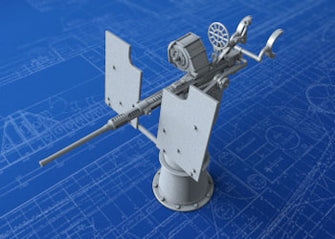1/96 Royal Navy 15" (38.1cm) MKI (HMS Abercrombie)
1/96 Scale Royal Navy 15" (38.1cm) MKI Turret for the HMS Abercrombie. This part is modelled from the builders plans with all the correct Turret Face angles and dimensions. Also using many reference photographs and information to make these the most precise and accurate 15" MKI's available. These are mixed Resin prints with the Main Gunhouse and Barrels printed by a 3rd party (Tough Grey HD Resin) and shipped directly. All the smaller detailed parts are printed using Micro Masters High Definition Resin for mind blowing results. Please Note: Detailed parts are shown in the lighter Resin in renders. Ideal for use with Micro Master 1/96 20mm MKI Oerlikons.
- 1x Turret
- Highly detailed and accurate parts, modelled from builders plans and photographic reference
-
Accurate armour thickness and dimensions
-
15ft Rangefinder
- Highly detailed AA platforms with open Oerlikon bandstands, non-slip patter and 20mm Ready-use Lockers
- Details include: Hex Nuts, Rivets, Stanchion Holders, Sighting Ports, Crew Access Hatches and accurate placement of crew Access Ladders.
- Detailed parts allow for the modeller to put all the hatches in place as desired. Crew Access Hatch at rear of Turret can be swung open.
- Barrels are printed separately and can be elevated as desired .
HISTORICAL DATA
This was quite possibly the best large-caliber naval gun ever developed by Britain and it was certainly one of the longest-lived of any nation, with the first ship-board firing taking place in 1915 and the last in 1954. The design of this weapon was largely based upon the 13.5"/45 (34.3 cm) Mark V and it was rushed into production, bypassing the normal - and lengthy - prototype stage. This shortened design cycle was approved by the Director of Naval Ordnance, Rear Admiral Archibald Moore, who staked his "professional existence" on its success. The reason for this rushed procedure was to allow what became the Queen Elizabeth class battleships to be armed with larger guns than would have otherwise been possible. Although their first warshots were for bombarding shore positions at Gallipoli in 1915, the value of these weapons was not truly shown until the Battle of Jutland (Skagerrak). In that battle, the British battleships with these guns were able to engage German battlecruisers at a range of 19,000 yards (17,400 m), which was beyond the maximum range of the guns on the German ships.
By the mid-1930s the Admiralty saw these guns as growing obsolete, as other nations had developed more powerful weapons, capable of longer ranges and firing heavier projectiles. Along with this, the ships carrying these guns were approaching twenty years of service and starting to show signs of wearing out. Inhibited by treaty restrictions from replacing the battleships, the British instead sought to rectify the situation by initiating a "modernization" program whereby the ships had major overhauls performed and had their weapons upgraded. There were two significant improvements made to these guns during the modernizations: 1) The upper elevation limit of the mountings was increased from 20 degrees up to 30 degrees, which raised their maximum range with 4crh projectiles from 23,700 yards up to 29,000 yards (21,670 m to 26,520 m), and 2) The projectiles were improved and a more streamlined ballistic cap (6crh) was fitted which increased the range still further to about 32,000 yards (29,260 m) at 30 degrees elevation. Thanks to these modifications, in July 1940 HMS Warspite made one of the longest hits ever scored by a naval gun on an enemy ship when she struck the Italian battleship Guilio Cesare at approximately 26,000 yards (23,770 m).
The rate at which these ships could be modernized was limited and by the start of World War II Malaya, Barham, Repulse and the five Royal Sovereign class battleships had not yet been upgraded. Royal Oak, Barham and Repulse were sunk early in the war, but the remaining unmodernized ships were given a "Super Charge" which consisted of the largest possible propellant charge that the guns and mountings could safely handle. These were issued starting in late 1941 and at the maximum elevation of 20 degrees allowed a range of 28,700 yards (26,240 m). However, from a study of the records, it would appear that no ship ever fired a shot using Super Charges, although they were used by the coastal artillery at Dover. Super Charges were not issued to ships with 30 degree mountings as the increased barrel wear and mounting stress was not considered to be acceptable. For this reason, sources which quote HMS Vanguard as having gun ranges in excess of 32,000 yards (29,260 m) are somewhat misleading, as such a range would have required the use of super charges, which she never carried.
SUPPORT REMOVAL, CLEANING & PAINTING GUIDE









